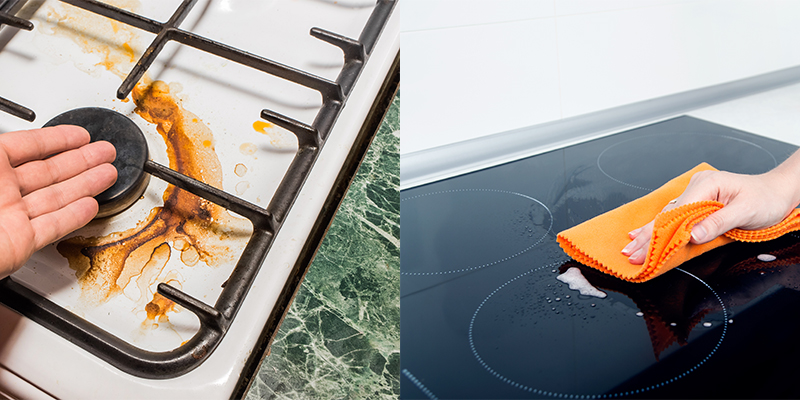Gas Stoves versus Induction Stoves
Gas stoves and induction cooktops are both popular choices when it comes to cooking, but the differences between them can be significant. The debate between gas stoves and induction stoves has been going on for decades, with both sides making convincing arguments as to why their preferred stove type is superior. Those who favor gas stoves point out that the flame offers an excellent level of heat control and responsiveness. It can adjust from low to high temperatures quickly and precisely, and the flame is also visible so that you can monitor the progress of your food as it cooks. On the other hand, induction stoves offer convenience and energy efficiency, plus they heat up quickly and cool down quickly. Induction cooktops use magnetic fields to create heat directly in the pot or pan itself. This means that foods will cook faster and with more even heat distribution than with a traditional gas cooktop. They require special pans which may not be compatible with everyone’s cookware, but aside from that, the performance is excellent. In this blog post, we will explore the pros and cons of each type of stove in order to help you make the decision that is best for your needs.
1. Gas stoves and Gas Cooking Heating Efficiency
Gas stoves and gas cooking heating has been around for a long time, yet more recently induction cooking has become increasingly popular. An induction cooktop is an induction range with a cooktop surface that uses electromagnetism to directly heat the pot or pan. This type of stovetop is very efficient as it directly heats the pot or pan instead of requiring heat to be transferred from a coil or electric cooktop. Natural gas is the most common fuel used for gas cooktops and can offer even faster and more precise heating than electricity. Pots and pans made from ferrous metals are best used on induction ranges as they get hot quickly and can reach high temperatures when necessary. Ceramic pots are not recommended as they can take too long to get hot. Gas stoves also offer the advantage of being able to simmer food without scorching it. It also offers greater control over temperatures than electric cooktops, making it ideal for delicate foods that require precise cooking times and temperatures.
One of the major advantages of gas stoves over induction stoves is that they are more heating efficient. This is due to the fact that gas stoves heat up quickly and evenly, and they can also be adjusted to a lower temperature more easily. Gas stoves also do not require a lot of energy to operate, meaning that they are often cheaper to run than induction stoves. Additionally, the open flame of a gas stove makes it easier to monitor the heat level, which can help with controlling the cooking temperature.
2. Gas or Induction? Cost Comparison
When it comes to cost comparison between gas and electricity, the debate is ongoing. Gas ranges and cooktops are usually cheaper than electric stoves, but an induction cooktop or range can be more expensive. Traditional electric cooktops and ranges may be cheaper than an induction stovetop, but with the efficiency of an induction burner, you may save some money in the long run. If you are considering switching from gas to electric or vice versa, you should consider all options before making a purchase. A gas burner will cost less than an induction burner initially, but may not be as efficient in the long run. An electric cooktop will also cost less upfront compared to an induction stovetop, but again may not be as efficient over time. Ultimately, when comparing costs between gas or electric appliances the best choice is dependent on your budget and how much you will use the appliance over time.
When it comes to cost comparison between gas stoves and induction stoves, the choice is a complicated one. Gas stoves are usually cheaper to buy, but they use more energy to run, which means that over time, your energy costs will be higher. Induction stoves are more expensive to purchase, but they require less energy to operate, meaning that their energy costs over time tend to be lower. Ultimately, the choice between gas or induction stoves will depend on the budget and the energy costs associated with the specific model you select.
3. Maintenance for Induction Range and Gas Range
Maintenance for induction cooktops and ranges is generally easier than electric or gas options. According to consumer reports, better than electric, cooking with gas can be a challenge. Gas and electric cooktops are an option for those who want the ease of an electric range but with the power of a gas or electric stove. When comparing gas versus electric, an induction range is often favored due to its energy efficiency and quick heating capabilities. Additionally, new cookware is required when using an induction range – it must be compatible with the range’s magnetic field. Regular maintenance for all types of cooktops includes cleaning the surface after each use and ensuring there are no cracks or signs of wear on the material. If any problems arise, proper repairs should be made immediately in order to keep the appliance functioning properly and safely.
Gas stoves require regular maintenance to keep the burners and grates in good shape. Usually, this means scrubbing the burners, cleaning the grates, and checking for and replacing worn parts. However, these tasks are much less frequent with an induction stove. Induction stoves only require occasional cleaning of the surface. This makes them much more convenient and easier to maintain in the long run.
4. Induction cooking versus Gas Cooking, Safety Features
When it comes to cooking, there are two primary types of cooktops available— gas and induction. Gas hookups have been the traditional choice for many years, but electric or induction cooktops are becoming increasingly popular. An electric coil is the type of cooktop most often seen in traditional gas stoves, whereas portable induction models are quickly gaining popularity as they offer greater safety features than their gas counterparts. Induction models work by creating a magnetic field that transfers heat directly to the pot or pan, which eliminates any open flame or hot coils that can cause burns. Radiant electric cooktops also provide a much safer option than gas stoves as they do not emit any fumes or produce an open flame. Both electric and induction cooktops offer safety features such as an automatic shut-off system if the temperature gets too high, making them a great option for families with small children. In addition, some cities have even taken steps to ban gas stoves due to their potential hazards, further demonstrating how induction cooking is becoming a safer alternative to traditional methods.
When it comes to safety features, gas stoves have a few key advantages. Firstly, they are less likely to cause severe burns, as they distribute heat more evenly. Plus, they can be adjusted quickly to turn off the heat when needed. On the other hand, induction stoves require special cookware, and if you use the wrong type of cookware, they can become very hot very quickly, posing a risk of burns. Additionally, they have an automatic shutoff feature that turns off the heat if the stove is left unattended for a certain amount of time.


5. Cooking Options for both Gas and Induction
When it comes to cooking options for both gas and induction, there are a few things to consider. The temperature on an induction cooktop is often more precise than on a gas cooktop, as the temperature can be adjusted in small increments or even turned off entirely. The cooking surface of an induction cooktop is also typically smoother and easier to clean than that of a gas stove, making switching from gas to induction easier. Additionally, although regular electric stoves may be less energy-efficient than an induction cooktop, they can still provide faster cooking times than their gas counterparts. All in all, whether you prefer the control of a gas stove or the convenience and speed of an induction cooktop, there are energy-efficient options available for both types of cooking.
When deciding which one is right for you, it’s important to consider the pros and cons of each. In general, gas stoves are cheaper and require less maintenance, while induction stoves heat up quickly and let you control the temperature precisely. Also, some cooks may be more familiar with gas stoves, while induction stoves use less energy and look more modern. Ultimately, the choice between the two comes down to the type of cooking you plan on doing and the features that are most important to you.
All in all, gas stoves and induction stoves each have their own advantages and disadvantages. Gas stoves heat up quickly and evenly and cost less than induction stoves. Induction stoves are safer and use less energy. Ultimately, the decision between gas and induction stoves comes down to the user’s individual needs and
preferences. It is important to weigh the pros and cons of each option before making a decision to ensure that the best choice is made.
Gas Stove, Induction Stove - Pros and Cons
Gas Stove Pros:
Gas Stove Cons:
Micro Induction Stove Pros:
Micro Induction Stove Cons:
Frequently Asked Questions
What are the differences between a gas stove and an induction stove?
Curious about induction? Induction cooking uses a type of electric cooktop that transfers energy directly to the pot or pan. The heat is generated by a magnetic field between the stovetop and the cookware, which means it heats up much faster than conventional electricity. Induction cooktops also offer precise temperature control and are very energy efficient. There is a bit of a learning curve with induction, as certain cooking techniques need to be adjusted for the best results, but once you get used to it, you will appreciate its speed and convenience. Additionally, not all cookware is compatible with induction so you may need to buy new pots and pans if you make the switch.
The main difference between a gas stove and an induction stove is the heat source. A gas stove uses an open flame to heat the pot, while an induction stove uses magnetic induction to generate heat. A gas stove is generally less expensive, while an induction stove is more efficient and quicker to heat up.
Which is better for cooking, a gas stove or an induction stove?
When it comes to cooking, the debate about a gas stove or induction stove can be confusing. Electric induction is a relatively new cooking technology that has revolutionized the way we cook. Electric ovens with new induction technology are much more efficient than traditional gas stoves. They work with induction by using an electromagnetic field instead of direct heat from a gas flame, which makes them faster than gas stoves and more energy efficient. An induction hob is comparable to a gas stove and can be used in the same way, but cooking with induction takes less time than with a gas stove. For those who prefer the control of a flame, the best gas stove might still be the preferred option; however, since induction is much faster and more energy efficient, it may be worth considering when choosing your next cooking appliance. Induction stoves offer many advantages over traditional gas stoves and make it very easy to use modern cooking technology in your home.
A: Choosing between a gas stove and an induction stove really depends on your cooking needs. Gas stoves are great for boiling and general cooking, while induction stoves are more suited for more delicate tasks such as simmering and sautéing.
Are there any safety concerns with using a gas stove or an induction stove?
Yes, safety should always be taken into consideration when using any type of cooking appliance. Both gas and induction stoves can be dangerous if not used properly. Gas stoves can produce carbon monoxide if the flame is left on too long or not extinguished properly. Induction stoves can generate a high level of heat if left too long in the same area.
When you’re trying to decide between a gas stove and an induction stove, there are some safety concerns to consider. Conventional electric stoves may be the most common choice, but comparable gas stoves are considered to be the safest option. Cooking with induction technology is becoming increasingly popular, as it is considered to be the best type of gas cooking technology. If you’re considering switching from gas to induction, make sure you find an induction cooktop that is right for you. Samsung offers several induction stoves that combine convenience and superior performance. When using an induction stove, it is important to keep in mind that it requires a special type of cookware in order for the technology to work correctly and safely. Electric stovetops also have their own safety concerns when it comes to keeping children away from hot surfaces. Ultimately, both types of stoves can be used safely as long as proper precautions are taken and instructions followed carefully.
How much do gas stoves and induction stoves cost?
Gas stoves vary in cost depending on the size and features of the stove. A basic gas stove with 4 burners typically ranges from $250 to $500. On the other hand, if you’re considering switching from gas to an induction cooktop, you can find Samsung induction cooktops starting at around $700 and going up to about $1,200 for higher-end models. The right cooktop for you depends on your cooking style and habits; if you’re looking for an electric option, a glass cooktop surface is best for cooking food evenly and quickly. When it comes to comparing induction vs gas stoves, both have their advantages and disadvantages. Induction stoves are more energy efficient than gas stoves but they can be pricier upfront. Gas stoves are cheaper but they lack the energy efficiency that induction offers. Ultimately, when choosing between the two, it comes down to your budget and how you plan on using it when cooking food.
Are there Any Health concerns with gas stoves and their dioxide emission?
Gas stoves can be a great and reliable way to cook, but there are some health concerns associated with them. Gas stoves emit carbon dioxide (CO2) which can be harmful to your health if the ventilation in your home is not adequate. If you're switching from gas to electric, you may want to look into finding an induction cooktop as it is more energy efficient and emits less CO2 than gas stoves. However, if a gas stove is right for you and your cooking habits, make sure to have proper ventilation in the kitchen area so that the CO2 emission does not become dangerous for you or your family.
Gas Cooking and Asthma
Gas cooking can present a challenge for those with asthma. Gas stovetops generate smoke and odors that can be difficult to remove from the air, leading to increased asthma symptoms. Fortunately, there are other options available for those looking to cook safely in their home. An induction cooktop is a great choice for anyone who suffers from asthma. Induction cooking is clean and efficient, as it doesn't produce any smoke or odors - making it much easier on your lungs. Plus, since the heat is generated directly in the pot or pan, it's much safer than traditional gas stoves as well. With an induction cooktop you can still enjoy all your favorite dishes without worrying about exacerbating your asthma symptoms. If you're looking to find a cooktop that is right for you and your lifestyle, then induction cooking may be the best choice for you.
Lorem ipsum dolor sit amet, consectetur adipiscing elit. Ut elit tellus, luctus nec ullamcorper mattis, pulvinar dapibus leo.
Disclaimer: We are part of the Amazon Services LLC Associates Program, an associate advertising program created to give us the opportunity to earn fees through links to Amazon.com and associated websites. The product cost for you remains unchanged, yet the tiny commissions help support us in offering you more captivating content like this one.

Have you ever wondered why most of the Vinaigrettes in the grocery store are made with 10, 20, sometimes even almost 30 ingredients? I remember growing up in Provence watching my mother whipping vinaigrettes before every single dinner. She would mix in a giant bowl, delicious extra virgin olive oil, a robust aged vinegar (the flavor would depend on the main dish), sea salt and pepper and voila! I decided to do the same thing for my family and friends more than 20 years ago here in this beautiful country. And Provence Kitchen® was born. Stay tune for more articles and wonderful family recipes..

